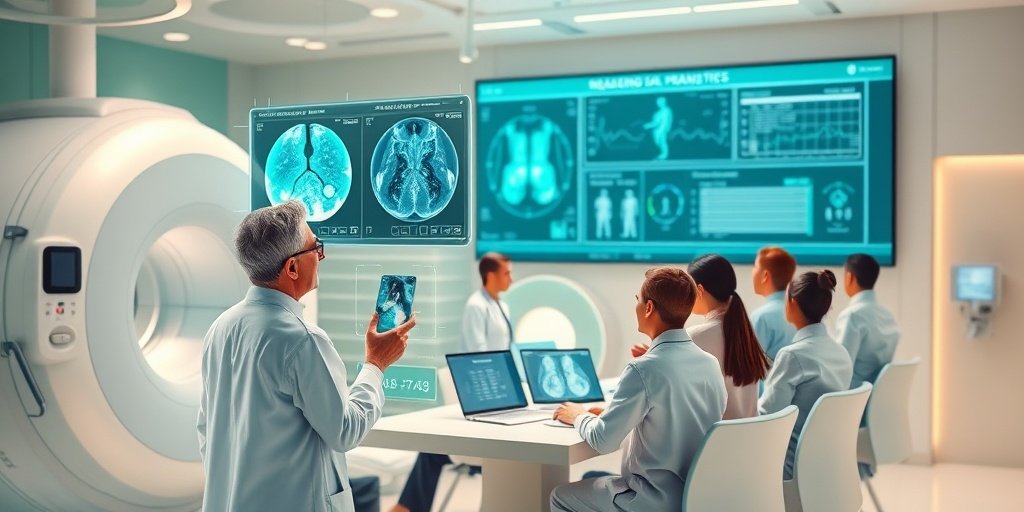⚡ Quick Summary
This article discusses the transformative role of artificial intelligence (AI) in radiology, emphasizing the need for visionary leadership to navigate the complexities of AI integration. By enhancing workflow efficiency and reducing administrative burdens, AI is set to redefine the future of radiology practice.
🔍 Key Details
- 📊 Focus: The impact of AI on radiology
- 🧩 Key Areas: Workflow management, diagnostics, reporting, and data analytics
- ⚙️ Leadership Role: Essential for ethical AI deployment and fostering innovation
- 🏆 Vision: Development of a “diagnostic cockpit” for precision diagnoses
🔑 Key Takeaways
- 🤖 AI will transform radiology by improving workflow efficiency and optimizing resource allocation.
- 💡 Strong leadership is crucial for ethical AI deployment and governance.
- 🌟 Visionary leaders must promote interdisciplinary collaboration to harness AI’s full potential.
- 📈 AI can enhance operational efficiency and reduce administrative burdens in radiology practices.
- 🔄 Transitioning to continuous learning systems is essential for adapting to evolving challenges.
- 🏥 Human-centered care should remain a priority as technology advances.
- 🌍 The future of radiology will be defined by leaders who embrace AI as a tool for enhancement, not replacement.

📚 Background
Radiology has come a long way since the introduction of X-ray imaging, evolving into a field characterized by rapid technological advancements. As the volume and complexity of imaging workloads increase, the integration of artificial intelligence presents both challenges and opportunities. The need for effective leadership in this transition is more critical than ever.
🗒️ Study
The article highlights the importance of leadership in radiology amidst the rise of AI technologies. It discusses how AI can streamline various aspects of radiology practice, from workflow management to diagnostics and reporting. The authors emphasize that successful AI integration requires not only technical knowledge but also an understanding of the human and organizational dynamics involved.
📈 Results
The findings suggest that AI can significantly enhance operational efficiency, reduce administrative burdens, and optimize resource allocation in radiology. However, the successful implementation of these technologies hinges on strong leadership and governance structures that ensure ethical compliance and effective oversight of AI algorithms.
🌍 Impact and Implications
The implications of this study are profound. As radiology moves towards an AI-driven future, the role of leaders will be pivotal in shaping how technology is integrated into practice. By fostering an environment of innovation and collaboration, leaders can ensure that AI enhances the capabilities of radiologists, ultimately improving patient care and outcomes.
🔮 Conclusion
The integration of artificial intelligence in radiology represents a significant opportunity for the field. With the right leadership and governance, AI can transform radiology practices, making them more efficient and patient-centered. As we look to the future, it is essential for leaders to embrace these changes and guide their teams through this exciting evolution in healthcare.
💬 Your comments
What are your thoughts on the integration of AI in radiology? How do you see leadership playing a role in this transformation? 💬 Share your insights in the comments below or connect with us on social media:
Leadership in radiology in the era of technological advancements and artificial intelligence.
Abstract
Radiology has evolved from the pioneering days of X-ray imaging to a field rich in advanced technologies on the cusp of a transformative future driven by artificial intelligence (AI). As imaging workloads grow in volume and complexity, and economic as well as environmental pressures intensify, visionary leadership is needed to navigate the unprecedented challenges and opportunities ahead. Leveraging its strengths in automation, accuracy and objectivity, AI will profoundly impact all aspects of radiology practice-from workflow management, to imaging, diagnostics, reporting and data-driven analytics-freeing radiologists to focus on value-driven tasks that improve patient care. However, successful AI integration requires strong leadership and robust governance structures to oversee algorithm evaluation, deployment, and ongoing maintenance, steering the transition from static to continuous learning systems. The vision of a “diagnostic cockpit” that integrates multidimensional data for quantitative precision diagnoses depends on visionary leadership that fosters innovation and interdisciplinary collaboration. Through administrative automation, precision medicine, and predictive analytics, AI can enhance operational efficiency, reduce administrative burden, and optimize resource allocation, leading to substantial cost reductions. Leaders need to understand not only the technical aspects but also the complex human, administrative, and organizational challenges of AI’s implementation. Establishing sound governance and organizational frameworks will be essential to ensure ethical compliance and appropriate oversight of AI algorithms. As radiology advances toward this AI-driven future, leaders must cultivate an environment where technology enhances rather than replaces human skills, upholding an unwavering commitment to human-centered care. Their vision will define radiology’s pioneering role in AI-enabled healthcare transformation. KEY POINTS: Question Artificial intelligence (AI) will transform radiology, improving workflow efficiency, reducing administrative burden, and optimizing resource allocation to meet imaging workloads’ increasing complexity and volume. Findings Strong leadership and governance ensure ethical deployment of AI, steering the transition from static to continuous learning systems while fostering interdisciplinary innovation and collaboration. Clinical relevance Visionary leaders must harness AI to enhance, rather than replace, the role of professionals in radiology, advancing human-centered care while pioneering healthcare transformation.
Author: [‘Wichtmann BD’, ‘Paech D’, ‘Pianykh OS’, ‘Huang SY’, ‘Seltzer SE’, ‘Brink J’, ‘Fennessy FM’]
Journal: Eur Radiol
Citation: Wichtmann BD, et al. Leadership in radiology in the era of technological advancements and artificial intelligence. Leadership in radiology in the era of technological advancements and artificial intelligence. 2025; (unknown volume):(unknown pages). doi: 10.1007/s00330-025-11745-4